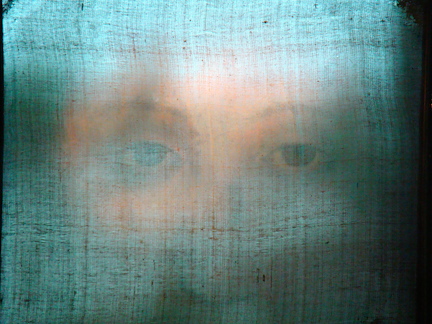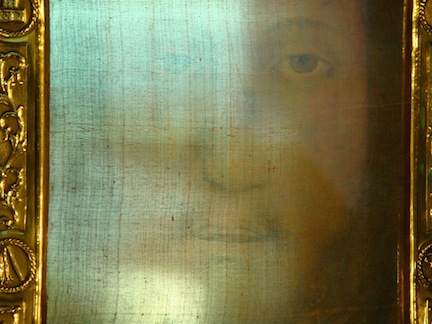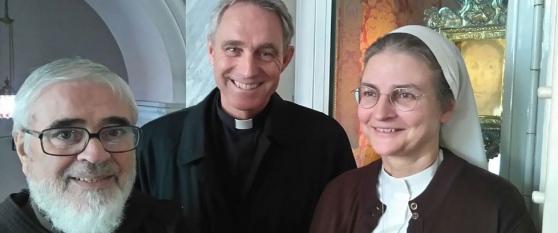October 30, 2015, Friday — Francis and The Face of Christ
“Jesus Christ is the face of the Father’s mercy. These words might well sum up the mystery of the Christian faith.” —Pope Francis, first words of the bull of indiction for the Holy Year of Mercy, entitled Misericordiae Vultus, April 11, 2015
“‘Patient and merciful.’ These words often go together in the Old Testament to describe God’s nature… In a special way the Psalms bring to the fore the grandeur of his merciful action: ‘He forgives all your iniquity, he heals all your diseases, he redeems your life from the pit, he crowns you with steadfast love and mercy’ (Ps 103:3-4)… Here are some other expressions of the Psalmist: ‘He heals the brokenhearted, and binds up their wounds… The Lord lifts up the downtrodden, he casts the wicked to the ground’ (Ps 147:3, 6). In short, the mercy of God is not an abstract idea, but a concrete reality with which he reveals his love as of that of a father or a mother, moved to the very depths out of love for their child. It is hardly an exaggeration to say that this is a ‘visceral’ love. It gushes forth from the depths naturally, full of tenderness and compassion, indulgence and mercy.” —Ibid.
“With our eyes fixed on Jesus and his merciful gaze, we experience the love of the Most Holy Trinity. The mission Jesus received from the Father was that of revealing the mystery of divine love in its fullness. ‘God is love’ (1 Jn 4:8,16), John affirms for the first and only time in all of Holy Scripture. This love has now been made visible and tangible in Jesus’ entire life. His person is nothing but love, a love given gratuitously. The relationships he forms with the people who approach him manifest something entirely unique and unrepeatable. The signs he works, especially in favour of sinners, the poor, the marginalized, the sick, and the suffering, are all meant to teach mercy. Everything in him speaks of mercy. Nothing in him is devoid of compassion.” —Ibid.
===================
(Here below, an image of the Holy Face of Manoppello, taken by German author Paul Badde. The lines of the fabric can be clearly seen. The image is at least 400 years old, and Badde argues that it is 2,000 years old, and the original model for all icons of Jesus. Badde has written a book on the Holy Face, published by Ignatius Press; Link to a video describing the book)
An Italian newspaper is reporting that Archbishop Georg Gaenswein, Prefect of the Pontifical Household for Pope Francis and Personal Secretary to Emeritus Pope Benedict VI this week traveled quietly to the Shrine of the Holy Face in the little Italian hill-town of Manoppello in the Abruzzi region of Italy, about a 3-hour drive east from Rome. (link)
The paper, Il Centro (evidently so named because it covers the news of central Italy), in its Pescara edition of yesterday, October 29, says Gaenswein made the trip “following a visit on Tuesday” (October 27) to the Shrine of the Eucharistic Miracle in Lanciano, also in Abruzzo. Therefore, the visit seems to have occurred either late on Tuesday, October 27, or on Wednesday, October 28 (the paper does not state the precise date or time, only that it came “after” the Tuesday visit to Lanciano).
Interestingly, the paper then speculates that Gaenswein was making this trip in order to prepare a visit to the Manoppello shrine during the Holy Year of Mercy by Pope Francis himself.
Such a papal visit does not seem impossible, primarily for two reasons:
(1) because Pope Benedict XVI visited the shrine on September 1, 2006, about a year and a half after his election; that visit, the first ever by a Pope, gave credibility to the pious belief that the unusual image kept now for nearly 400 years in Manoppello, since the mid-1600s, is a mysterious “not made by human hands” image of Jesus Christ worthy of respect and veneration, and it set a possible precedent for other Popes, like Francis, to follow; and
(2) the first two words of Francis’ recent bull of indiction for the upcoming Jubilee of Mercy are precisely “Misericordiae Vultus” — “The Face of Mercy” (literally, “Of mercy the face”) — referring to the face of Christ; this suggests that it would not be out of the realm of the possible for Pope Francis to wish to venerate the image conserved in Manoppello.
Since 2001, when I first decided to go out from Rome to see the Holy Face of Manoppello for myself, I have been able to visit the tiny village and shrine a dozen or more times — even to stay with the friars at the shrine for several days. (Each year, our magazine brings small groups of pilgrims to the shrine as part of our Inside the Vatican pilgrimages to Rome and central Italy.) Over the years, I have come to know the rector of the shrine, Franciscan Father Carmine Cucinelli, Sister Petra Maria Steiner and Sister Blandine Schlömer, two German nuns who have studied the image for many years, and I have begun to write a book on the Holy Face, which I hope to finish before the end of the Holy Year.
(In recent years, there has also been increasing interest in the Holy Face on the part of some Orthodox Christians, including Russian Orthodox, who have been coming to Manoppello in increasing numbers, by the dozens and the hundreds. But some Russians have said that, if it were permitted to transport the image abroad, even to Russia — for example, to the Church of Our Lady of Kazan on Red Square in Moscow — that the number of Russians who might come to see and venerate the image might be in the millions… The bishop in charge of the diocese where Manoppello lies is Archbishop Bruno Forte, but the final decision on any such transport and display abroad would have to be made by Pope Francis himself…)
Here below is my translation of the article published yesterday in Italy about Gaenswein’s visit to Manoppello….
(Another photo of the Holy Face, also taken by Paul Badde; the image is transparent when photographed against a light background; it is inside two panes of glass held in place by a metal frame)
Father Georg in Abruzzo, The Hypothesis: Pope Francis Is Coming
The surprise visit of the Prefect of the Papal Household to the Basilica of the Holy Veil follows a stop Tuesday at the Eucharistic miracle. The German archbishop accompanied Pope Benedict XVI in 2006
By Walter Teti
October 29, 2015
(Monsignor Georg Gänswein, center, with Father Carmine Cucinelli (left) and Sister Petra Maria Steiner (right) in Manoppello this week)
MANOPPELLO — German Archbishop Georg Gänswein, the personal secretary and main collaborator of Pope Benedict XVI, who also Pope Francis wished to confirm in his role, visited privately the shrine of the Holy Face, accompanied by two religious. The visit to Manoppello followed a visit that the high-ranking prelate made Tuesday to the Eucharistic Miracle of Lanciano: a path between the two Abruzzesi cornerstones of Christianity that for years have been proposed for all pilgrims.
It seems fitting to point out that, since December 2012, Monsignor Gänswein also holds the influential post of Prefect of the Papal Household which handles the Holy See’s relations with heads of state and with the leaders of other Churches. “The arrival of Monsignor Gänswein had not been announced in advance,” Father Carmine Cucinelli, Rector of the shrine, said. “His visit took us by surprise, making us very happy indeed, because it was a welcome return.”
Monsignor Georg — as he is commonly known in Italy because of his complicated surname — first arrived in Manoppello with Benedict XVI on the occasion of the historic papal pilgrimage of September 1, 2006 in Abruzzo. His surprise return nourishes the hypothesis of a future visit to the shrine by Pope Francis during the special Jubilee of Mercy. An invitation to the Pope was in fact already addressed by the friars of Manoppello, via the Superior General of the Capuchins, Father Mauro Johry father, during the latter’s visit to Manoppello last June, in the presence of the provincial for the Abruzzo region, Father Carmine Ranieri.
Reinforcing this hypothesis is the simultaneous visit of Monsignor Georg to Lanciano, where the keepers of the Eucharistic Miracle are also Franciscans.
In short, the arrival of the Archbishop allows the pleasant thought that the Pope, during the Jubilee year, might visit Abruzzo, stopping both in Lanciano and in Manoppello.
In this regard, it should be noted that the bull of indiction for the Jubilee by Pope Francis — Misericordiae Vultus — begins by recalling the very face of Christ: “Jesus Christ is the face of the Father’s mercy. These words might well sum up the mystery of the Christian faith.”
Monsignor Georg, having spent time in prayer before the Holy Face, visited the exhibition on the Holy Veil set up in the basilica and listened to the explanations of Father Paolo Palombarini and Sister Petra-Maria Steiner, a German nun who lives in Manoppello and is engaged in the dissemination of knowledge of the Holy Face as well as in the reception of pilgrims and in support of the needy.
Georg, before leaving the basilica, signed the guest book to formalize his presence without leaving any comment.
Here is the beginning of an article on the Holy Face of Manoppello which appears in Wikipedia on the internet (link).
The Wikipedia Article
The Manoppello Image is an image of a face on a cloth (17.5 cm wide and 24 cm high) that is stored in a church in the village of Manoppello, Italy. The church, known as Santuario del Volto Santo, is part of a monastery belonging to Capuchin monks. There have been claims that the cloth is the Veil of Veronica.
Background
According to local tradition, an anonymous pilgrim arrived in Manopello in 1508 with the cloth wrapped in a package. The pilgrim gave the package to Dr. Giacomo Antonio Leonelli, who was sitting on a bench in front of the church. The doctor went into the church and unwrapped the package, discovering the veil. He immediately left the church to find the pilgrim but could not trace him.
The veil was owned by the Leonelli family for a century.
In 1608, Pancrazio Petrucci, a soldier married to Marzia, a member of the Leonelli family, stole the veil from his father-in-law’s house. A few years later, Marzia sold it for 400 scudi to Doctor Donato Antonio De Fabritiis to pay a ransom demand for her husband who was a prisoner in Chieti. The veil was given by De Fabritiis to the Capuchins who hold it today.
This history has been documented by Father Donato da Bomba in his “Relatione historica” and is based on research that had been started in 1640.
In 1999, German Jesuit Father Heinnrich Pfeiffer, Professor of Art History at the Pontifical Gregorian University, announced at a press conference in Rome his discovery of the veil in the church of the Capuchin monastery, where it had been since 1660. Pfeiffer had in fact been promoting this image for many years before.
Pfeiffer claims that the image is the Veil of Veronica. He suggests that it was stolen from the Vatican during rebuilding that took place in 1506, before the Sacking of Rome. He further suggests the cloth was placed over Jesus’ face in the tomb and that the image was a by-product of the forces unleashed during Jesus’ resurrection — forces, he believes, that also formed the image on the Shroud of Turin. Additionally, he has proposed a history of the veil going back to the first century…
…the cloth has received much publicity in recent years and Pope Benedict XVI visited the veil on 1 September 2006...
(Below, a third photo of the Holy Face of Manoppello, also taken by Paul Badde)
What is the glory of God?
“The glory of God is man alive; but the life of man is the vision of God.” —St. Irenaeus of Lyons, in the territory of France, in his great work Against All Heresies, written c. 180 A.D.











Facebook Comments